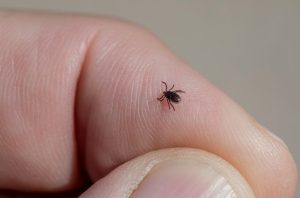
More than 800 species of ticks drink the blood of mammals, birds and sometimes reptiles and amphibians. Ticks live in grassy and wooded areas around the world, mostly in warm, humid clients, but some species can be found in more arid parts. Not all carry disease, but many do, as many as 150 different diseases! As dog moms and dads, the types we are the most concerned with are:
American Dog Tick (Dermacentor variabilis): These ticks are found mostly in grassy areas with little to no tree cover. They feed on hosts of all sizes and can carry Rocky Mountain spotted fever (various clinical signs including neurologic and painful hypersensitivity).
Brown Dog Tick (Rhipicephalus sanguineus): These ticks are found all over the world and in all parts of the United States, though most heavily concentrated in the south. Brown dog ticks can transmit Anaplasmosis (bacterial disease infecting white blood cells or platelets), Rocky Mountain spotted fever and Canine Ehrlichiosis (can affect platelets, lymph node enlargement and neurologic abnormalities).
Gulf Coast Tick (Amblyomma maculatum): The Gulf Coast Tick, via ingestion, transmits American Canine Heptozoonosis, which can debilitate a dog’s bones and muscles and abnormally increase white blood cells.
Deer Tick (Ixodes scapularis): Also known as the blacklegged tick, the deer tick is commonly found in deciduous forest areas and may carry Lyme disease (lameness due to inflammation of the joints), Anaplasmosis and/or Babesiosis (resulting in hemolytic anemia).
Lone Star Tick (Amblyomma americamm): This type of tick is primarily found in areas of dense undergrowth and in woodland areas. Lone star ticks can carry Rocky Mountain spotted fever and Ehrlichiosis.
Wood Tick (Dermacentor andersoni): Also known as the Rocky Mountain wood tick, they are primarily found in lightly wooded areas, grasslands and shrub land. Wood ticks can transmit Rocky Mountain spotted fever and have a type of neurotoxin in their saliva which can lead to tick paralysis in both pets and humans.
Where you and your pooch or kitty live will help you determine the best methods of flea and tick prevention to use. Searching on the internet will put great fear in you regarding preventatives as almost every brand is connected to a horror story about the product causing harm to some pet. Do realize, a potentially bigger risk exists in NOT preventing these pests from biting your pet, so speak to your veterinarian who knows your dog and what tick diseases exist in your neck of the woods, or wherever you may be travelling with your dog.
Always ask your veterinarian what he or she uses on his or her own pets and what is best for your individual dog or cat. Some preventives react negatively to certain health conditions and/or medications so your vet knows best. Most problems that occur are due to human error, so read directions thoroughly and consult with your pet’s second-best friend, his veterinarian. Never randomly choose anything that goes on or in your pet, even if it seems to be good for another pet.
Learn more here and get yourself into a Pet First Aid Class this summer to learn more tips about helping your dog or cat live a longer, happier, healthier life with you! Contact YOUR NAME/EMAIL/WEBSITE for details








